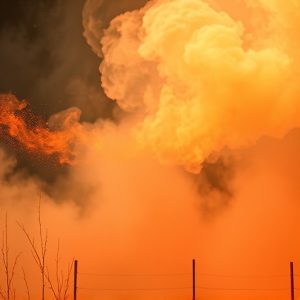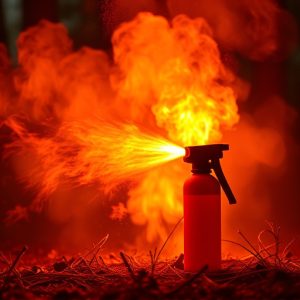Mastering Wildfire Pepper Spray: Your Guide to Safe Self-Defense
Wildfire pepper spray is a vital non-lethal self-defense tool that uses OC (Oleoresin Capsicum) to …….
Wildfire pepper spray is a vital non-lethal self-defense tool that uses OC (Oleoresin Capsicum) to temporarily incapacitate attackers. The main ingredient, capsaicin, causes intense irritation to the eyes and respiratory system, disorienting assailants and creating an opportunity for escape. It projects a potent cone of spray up to 12 feet and affects mucous membranes instantly with symptoms like severe eye pain, coughing, sneezing, and vision impairment. Users should train with the different types of Wildfire pepper spray available, including those designed for adverse weather or for everyday carry. The effectiveness of this defense mechanism relies on proper usage and understanding its workings. It's essential to consider the product's concentration of OC, delivery method, environmental reliability, safety features, and user-friendly design when selecting a Wildfire pepper spray that suits personal self-defense needs. Proper application technique and legal compliance are crucial, with safe practice sessions highly recommended. Regular maintenance is key to ensure the pepper spray functions correctly in critical situations. Wildfire pepper spray is a reliable component of a comprehensive personal safety strategy, best used alongside awareness, conflict avoidance, and basic self-defense skills.
When prioritizing personal safety, especially in unpredictable environments, understanding the best defensive tools is paramount. Among these, wildfire pepper spray emerges as a critical self-defense solution. This article delves into the intricacies of wildfire pepper spray, dissecting its potent components and the mechanisms that make it an effective deterrent. We’ll examine top-rated products on the market, providing a comprehensive evaluation to guide your choice. Additionally, we’ll outline essential strategies for safe and effective use, ensuring you are well-prepared should the need arise. Whether for personal protection or wilderness defense, wildfire pepper spray is an indispensable self-defense companion.
Understanding Wildfire Pepper Spray: Components and Mechanisms
When it comes to personal safety, understanding the components and mechanisms of Wildfire pepper spray is crucial for effective self-defense. Wildfire pepper spray is a non-lethal self-defense tool designed to incapacitate an attacker by delivering a powerful burst of OC (Oleoresin Capsicum) pepper spray. The active ingredient, capsaicin, is the compound responsible for the intense heat and irritation caused by the spray. Upon deployment, the fine droplets or foam disperse in a targeted cone pattern up to 12 feet away, aiming to strike the mucous membranes of an assailant’s eyes, face, and respiratory system. This immediate onset of pain and disorientation buys valuable time for you to escape and seek safety. The effects of Wildfire pepper spray are temporary but potent, with symptoms including extreme eye pain, coughing, sneezing, and an inability to see or continue the attack. Users should familiarize themselves with the proper use and storage of this self-defense tool, as it is most effective when used correctly. Additionally, Wildfire pepper spray comes in various forms, including keychain models, foam sprays for windy conditions, and larger cans for broader protection, ensuring that there’s an option suited for every individual’s needs and situations. Understanding the science behind Wildfire pepper spray is essential for confidently incorporating it into your self-defense strategy. Its targeted delivery system and potent active ingredients make it a reliable choice for those looking to enhance their personal safety.
Evaluating the Top Wildfire Pepper Spray Products on the Market
When considering a personal defense mechanism, wildfire pepper spray stands out as an effective and non-lethal option for deterring attackers. Evaluating the top products in this category requires a close look at several key factors that distinguish one pepper spray from another. The potency of the active ingredient, oleoresin capsicum (OC), is paramount; it should be of high concentration to ensure maximum effectiveness. A effective wildfire pepper spray typically contains between 1% and 2% OC, which can cause intense irritation to the eyes, skin, and respiratory system of an assailant. The delivery mechanism also plays a crucial role; sprays that offer a stream or foam option cater to different scenarios, such as close-range or long-distance encounters. Additionally, the reliability of the spray’s deployment under various conditions is essential. Users should test the product to ensure it functions correctly in extreme temperatures and weather conditions, as environmental factors can impact its performance. Safety features, such as a safety lock and a UV dye that marks an attacker for identification post-incident, are also valuable enhancements. Furthermore, the spray’s keychain attachment or pocket-friendly design allows for easy access, which is critical in a self-defense situation. Users should research and compare these elements across different wildfire pepper spray products to identify the one that best suits their personal safety needs. By carefully evaluating the market’s offerings, individuals can select a wildfire pepper spray that provides the confidence and protection necessary for effective self-defense.
Strategies for Effective Use and Safety Considerations with Wildfire Pepper Spray
When integrating wildfire pepper spray into your self-defense strategy, it’s crucial to understand its effective use and safety considerations. Proper deployment requires aiming for the eyes or face of an attacker from a safe distance, typically between 8 to 12 inches away. Practice using the spray in controlled environments to familiarize yourself with its range and effects. Safety glasses should be worn during practice sessions to prevent accidental exposure to your own eyes. Always keep the canister upright and ensure that your fingers are away from your face when discharging the spray. Additionally, it’s important to know local laws regarding pepper spray use, as some jurisdictions have specific regulations on its possession and application. In the event of an accidental discharge indoors, immediate ventilation of the area is necessary to dilute the spray and minimize its impact. Carrying a wildfire pepper spray should be part of a comprehensive personal safety plan that includes awareness of your surroundings, avoiding high-risk situations, and learning basic self-defense techniques. Regularly inspect your pepper spray canister for any signs of wear or damage, and replace it according to the manufacturer’s recommended schedule to ensure its effectiveness when needed.


